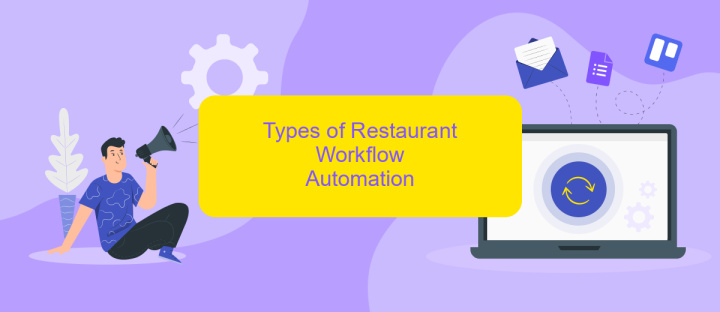Restaurant Workflow Automation
In the fast-paced world of dining, restaurant workflow automation is revolutionizing operations, enhancing efficiency, and elevating customer experiences. By integrating advanced technologies such as AI, IoT, and cloud computing, restaurants can streamline tasks, reduce errors, and optimize resource management. This article explores the transformative impact of automation on the restaurant industry, highlighting key benefits and practical applications.
Introduction to Restaurant Workflow Automation
Restaurant workflow automation is revolutionizing the way eateries operate by streamlining processes and enhancing efficiency. By automating repetitive tasks and integrating various systems, restaurants can focus more on providing exceptional customer experiences and less on manual labor.
- Order management: Automate order taking and processing to reduce errors and speed up service.
- Inventory control: Use automated systems to monitor stock levels and reorder supplies when necessary.
- Staff scheduling: Optimize staff schedules with automated tools to ensure adequate coverage during peak hours.
- Customer relationship management: Enhance customer interactions with automated loyalty programs and personalized marketing.
Integrating these automated systems can be simplified with tools like ApiX-Drive, which helps connect different software and services seamlessly. By leveraging such integrations, restaurants can achieve a cohesive and efficient workflow, ultimately leading to higher productivity and customer satisfaction.
Benefits of Restaurant Workflow Automation

Restaurant workflow automation significantly enhances operational efficiency by streamlining various processes. Automated systems reduce manual tasks, allowing staff to focus on delivering exceptional customer service. This leads to quicker order processing, accurate inventory management, and timely restocking, ultimately minimizing waste and reducing operational costs. Furthermore, automation enhances communication between kitchen and front-of-house staff, ensuring seamless coordination and faster service delivery.
Incorporating tools like ApiX-Drive facilitates seamless integration of various software systems within a restaurant. By automating data transfer between POS systems, inventory management, and reservation platforms, ApiX-Drive ensures that all systems are synchronized. This not only saves time but also reduces the potential for human error. Additionally, having a unified system allows managers to generate comprehensive reports, providing valuable insights that can be used to make informed business decisions and optimize overall restaurant performance.
Types of Restaurant Workflow Automation

Restaurant workflow automation can significantly enhance operational efficiency and improve customer experience. There are various types of automation that can be implemented to streamline different aspects of restaurant management.
- Order Management Automation: This involves automating the process of taking and processing orders through digital kiosks, mobile apps, or online platforms.
- Inventory Management Automation: Automating inventory tracking helps in maintaining optimal stock levels and reducing waste.
- Staff Scheduling Automation: Tools can automate the scheduling of staff shifts, ensuring optimal coverage and reducing scheduling conflicts.
- Customer Relationship Management (CRM) Automation: Automating CRM helps in managing customer data, preferences, and feedback efficiently.
- Integration Automation: Services like ApiX-Drive can be used to automate the integration of various software systems, ensuring seamless data flow and operational harmony.
Implementing these types of automation can lead to more streamlined operations, allowing restaurant staff to focus more on delivering excellent service and enhancing the overall dining experience for customers.
How to Implement Restaurant Workflow Automation

Implementing restaurant workflow automation begins with identifying the repetitive tasks that can be streamlined. These tasks often include order processing, inventory management, and customer service. By automating these processes, restaurants can significantly improve efficiency and reduce human error.
Next, choose the right tools and software to facilitate automation. Look for solutions that integrate seamlessly with your existing systems. For example, ApiX-Drive offers a range of integrations that can connect your point-of-sale system with inventory management, online ordering platforms, and more.
- Identify repetitive tasks for automation
- Choose compatible tools and software
- Integrate systems using services like ApiX-Drive
- Train staff on new automated processes
- Monitor and adjust workflows as needed
After implementing the automation tools, it is crucial to train your staff. Ensure they understand how to use the new systems and are aware of the benefits. Finally, continuously monitor the automated workflows and make adjustments as needed to optimize performance and address any issues that arise.
Best Practices for Restaurant Workflow Automation
To optimize restaurant workflow automation, it is crucial to implement a robust Point of Sale (POS) system that integrates seamlessly with other operational tools. This ensures real-time data synchronization, reducing errors and improving efficiency. Regularly update and maintain your POS system to leverage new features and security updates. Staff training on using these automated systems is equally important to minimize resistance and ensure smooth adoption.
Integrating your POS system with online ordering platforms, inventory management, and customer relationship management (CRM) tools can further streamline operations. Services like ApiX-Drive facilitate these integrations by automating data transfer between different systems, saving time and effort. Additionally, monitor and analyze data from these systems to identify bottlenecks and areas for improvement. Regularly reviewing and refining your automated processes will help maintain a high level of efficiency and customer satisfaction.


FAQ
What is restaurant workflow automation?
How can automation benefit my restaurant?
What processes in a restaurant can be automated?
How do I integrate different automation tools in my restaurant?
Is it difficult to implement automation in an existing restaurant setup?
Apix-Drive is a universal tool that will quickly streamline any workflow, freeing you from routine and possible financial losses. Try ApiX-Drive in action and see how useful it is for you personally. In the meantime, when you are setting up connections between systems, think about where you are investing your free time, because now you will have much more of it.

